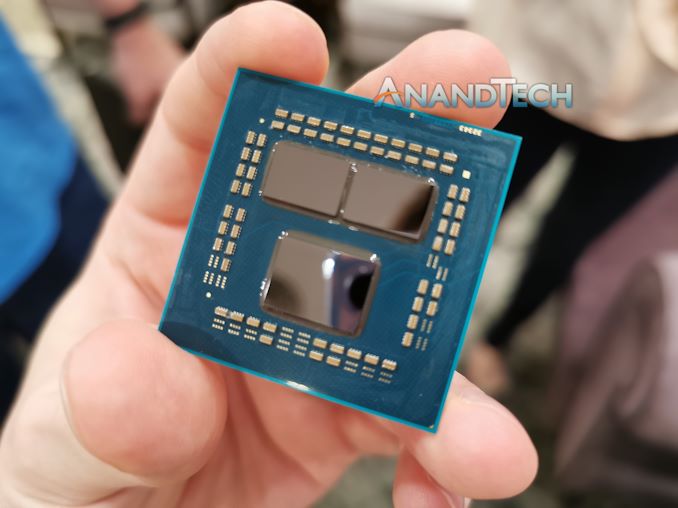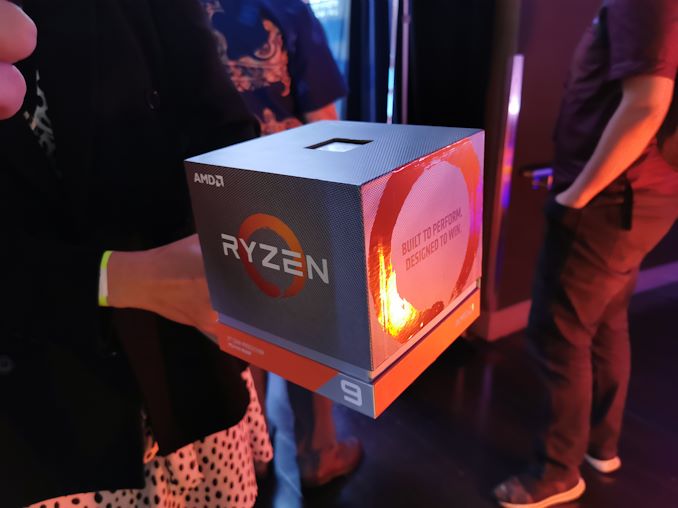AMD 16-Core Ryzen 9 3950X: Up to 4.7 GHz, 105W, Coming September
by Dr. Ian Cutress on June 11, 2019 6:00 PM EST- Posted in
- CPUs
- AMD
- Ryzen
- Zen 2
- Ryzen 3000
- Ryzen 3rd Gen
- Ryzen 9
- 3950X

One of the questions that was left over from AMD’s Computex reveal of the new Ryzen 3000 family was why a 16-core version of the dual-chiplet Matisse design was not announced. Today, AMD is announcing its first 16 core CPU into the Ryzen 9 family. AMD stated that they’re not interested in the back and forth with its competition about slowly moving the leading edge in consumer computing – they want to launch the best they have to offer as soon as possible, and the 16-core is part of that strategy.
The new Ryzen 9 3950X will top the stack of new Zen 2 based AMD consumer processors, and is built for the AM4 socket along with the range of X570 motherboards. It will have 16 cores with simultaneous multi-threading, enabling 32 threads, with a base frequency of 3.5 GHz and a turbo frequency of 4.7 GHz. All of this will be provided in a 105W TDP.
| AMD 'Matisse' Ryzen 3000 Series CPUs | |||||||||||
| AnandTech | Cores Threads |
Base Freq |
Boost Freq |
L2 Cache |
L3 Cache |
PCIe 4.0 |
DDR4 | TDP | Price (SEP) |
||
| Ryzen 9 | 3950X | 16C | 32T | 3.5 | 4.7 | 8 MB | 64 MB | 16+4+4 | ? | 105W | $749 |
| Ryzen 9 | 3900X | 12C | 24T | 3.8 | 4.6 | 6 MB | 64 MB | 16+4+4 | ? | 105W | $499 |
| Ryzen 7 | 3800X | 8C | 16T | 3.9 | 4.5 | 4 MB | 32 MB | 16+4+4 | ? | 105W | $399 |
| Ryzen 7 | 3700X | 8C | 16T | 3.6 | 4.4 | 4 MB | 32 MB | 16+4+4 | ? | 65W | $329 |
| Ryzen 5 | 3600X | 6C | 12T | 3.8 | 4.4 | 3 MB | 32 MB | 16+4+4 | ? | 95W | $249 |
| Ryzen 5 | 3600 | 6C | 12T | 3.6 | 4.2 | 3 MB | 32 MB | 16+4+4 | ? | 65W | $199 |
AMD has said that the processor will be coming in September 2019, about two months after the initial Ryzen 3rd Gen processors, due to extra validation requirements. The chip uses two of the Zen 2 eight-core chiplets, paired with an IO die that provides 24 total PCIe 4.0 lanes. By using the AM4 socket, AMD recommends pairing the Ryzen 9 3950X with one of the new X570 motherboards launched at Computex.
With regards to performance, AMD is promoting it as a clear single-thread and multi-thread improvement over other 16-core products in the market, particularly those from Intel (namely the 7960X).
There are several questions surrounding this new product, such as reasons for the delay between the initial Ryzen 3000 launch to the 3950X launch, the power distribution of the chiplets based on the frequency and how the clocks will respond to the 105W TDP, how the core-to-core communications will work going across chiplets, and how gaming performance might be affected by the latency differences going to the IO die and then moving off to main memory. All these questions are expected to be answered in due course.
Pricing is set to be announced by AMD at its event at E3 today. We’ll be updating this news post when we know the intended pricing.
Update: $749
Related Reading
- AMD Ryzen 3000 Announced: Five CPUs, 12 Cores for $499, Up to 4.6 GHz, PCIe 4.0, Coming 7/7
- AMD Ryzen 3rd Gen 'Matisse' Coming Mid 2019: Eight Core Zen 2 with PCIe 4.0 on Desktop
- AMD: 3rd Gen Ryzen Threadripper in 2019
- AMD Confirms PCIe 4.0 Not Coming to Older Motherboards (X470, X370, B350, A320)
- ASUS Pro WS X570-Ace: A No-Nonsense All-Black Motherboard with x8/x8/x8
- GIGABYTE Unveils X570 Mini-ITX Motherboard: X570 I Aorus Pro WiFi
- ASRock X570 Aqua: Heaviest AMD Flagship Motherboard Ever (Plus Thunderbolt)
- MSI Unveils the MEG X570 Ace: Black and Gold For AMD 50












172 Comments
View All Comments
Integr8d - Tuesday, August 13, 2019 - link
All good. Mouthbreathers won't know the difference. But where AMD plans to make money (enterprise), those ppl know the difference ;)Darkstone - Tuesday, June 11, 2019 - link
TDP means neither total not typical design power. It means Thermal Design Power. The TDP indicates requirements for the cooling, not for the power delivery circuit. In general a cooler with TDP 45w is designed to dissipate 45W of energy, but of course this doesn't mean you can't draw 50w for a short time.https://en.wikipedia.org/wiki/Thermal_design_power
ats - Wednesday, June 12, 2019 - link
TDP has always meant Thermal Design Power. The T has never meant Typical or Total. Nor has TDP ever had anything to do with continuous or instantaneous power draw, they are completely orthogonal.Gastec - Wednesday, June 19, 2019 - link
WORD!Byte - Tuesday, June 11, 2019 - link
how...how did AMD pull this out of their pants and into intels uranus?Gondalf - Tuesday, June 11, 2019 - link
You know....right now 8 core Ryzens are rated 105W but draw 145W under load.So these are marketing numbers. Bet this 16 core thing will be 180W under heavy tasks.
behrouz - Tuesday, June 11, 2019 - link
That's thermal design power.If Ryzen is rated 105w , doesn't mean this consumes 105w.rather this means if you buy CPU Cooler rated at 95w, then Ryzen will throttle.FMinus - Tuesday, June 11, 2019 - link
Do they? At stock? I doubt.Irata - Tuesday, June 11, 2019 - link
At least not according to Anandtech's (or Tom's) Ryzen 2700x review.Tom had 104.7 W total package power consumption for the 2700x in their torture loops (vs. 159.5 for the i7-8700k).
Anand had 106.38W for the 2700x (vs. 122.29 for the i7-8700) total package power consumption under load.
Both sites may measure this differently - not sure how THG does it, but AT use the processors internal registers to estimate power consumption.
RiCHeeGee - Tuesday, June 11, 2019 - link
My 2700 (non-x) @ 4.2ghz 1.4v vcore and 1.1v SOC draws 135w total with 120w on CPU and 15w on SOC. This is probably higher than usual due to it being a lower binned chip that requires more voltage to operate at these clocks.